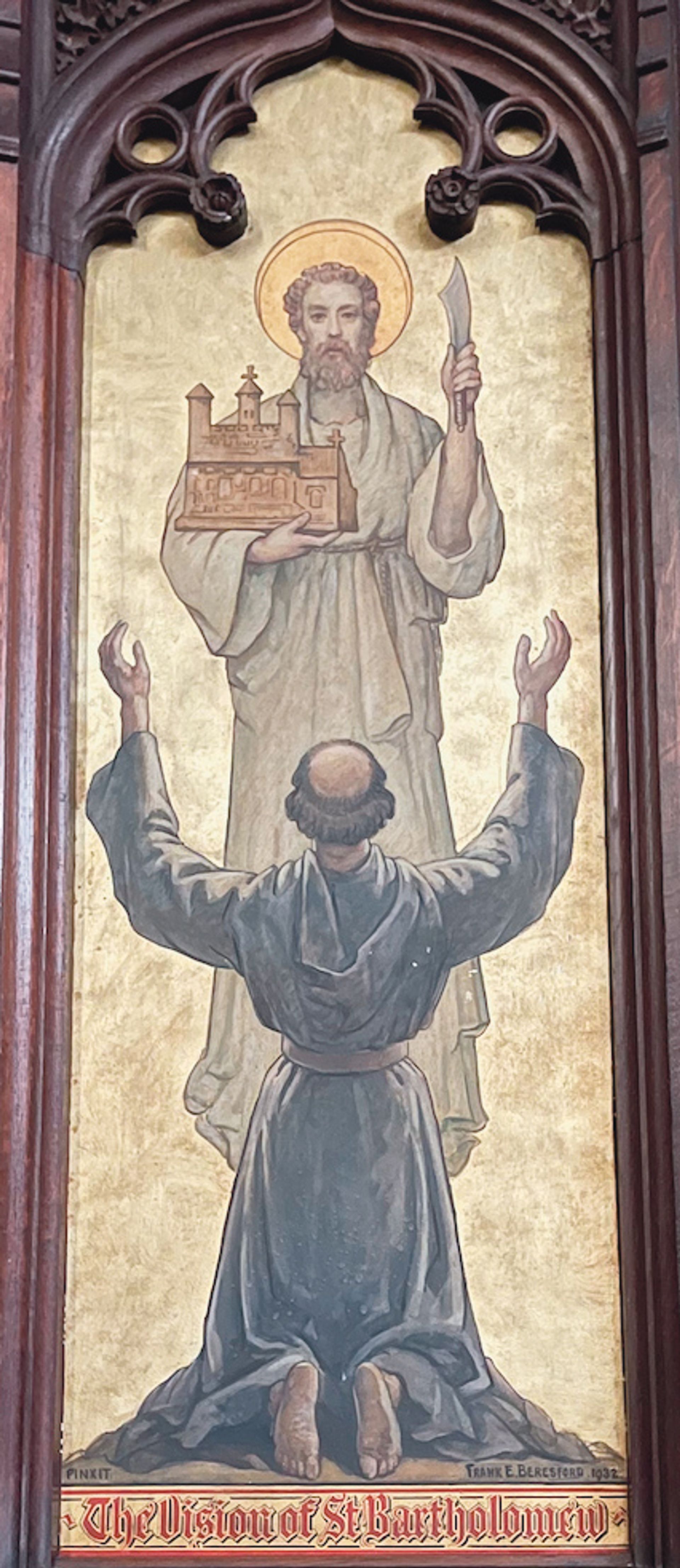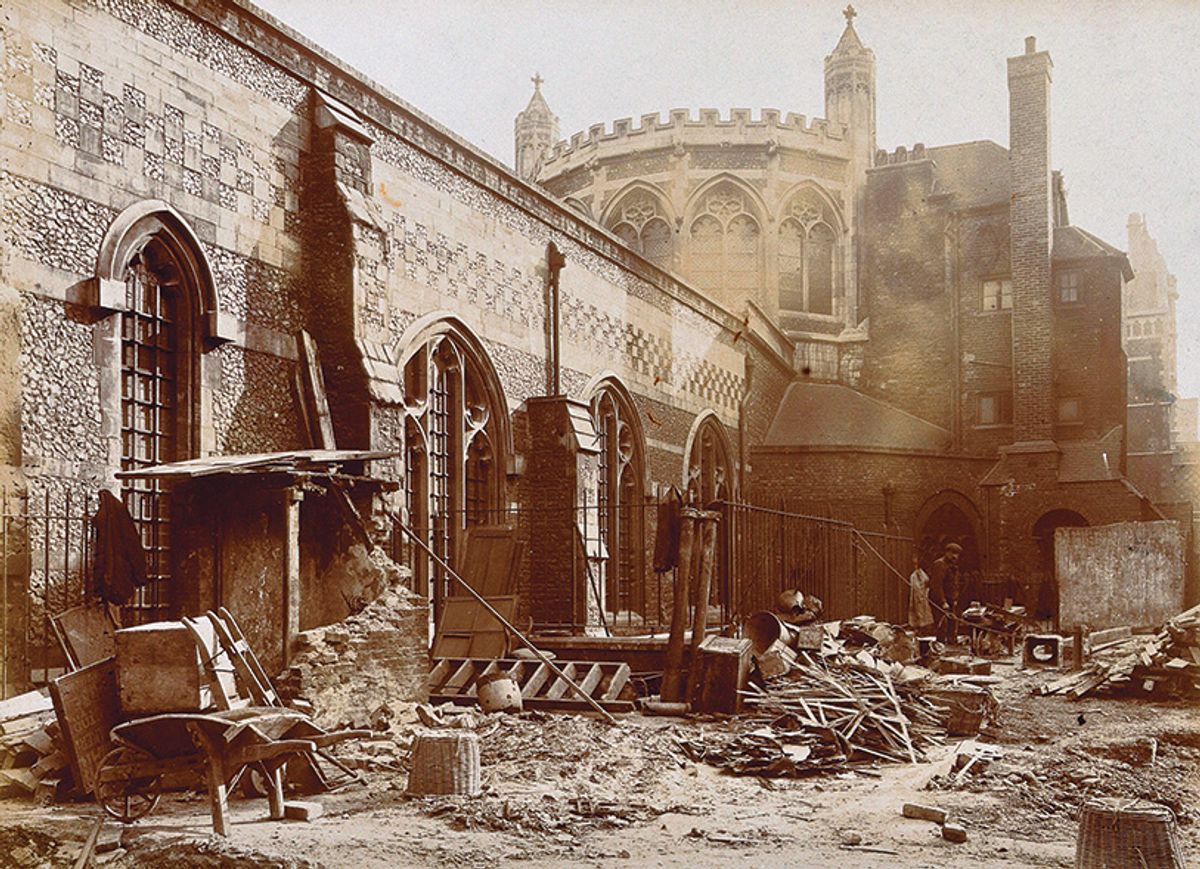In March 1123 work began on the construction of an Augustinian priory and hospital to the west of Smithfield, a royal livestock market then just outside the walls of London between Aldgate and Newgate. The founder of this institution was one Rahere, by tradition a jester in the service of Henry I (though little is in fact reliably known about him). Rahere, we are told by his anonymous 12th-century biographer, undertook this pious project as the result of a spiritual conversion. While making a pilgrimage to Rome he had a bout of fever and promised—if he recovered—to found a hospital for the poor. He soon thereafter experienced a vision in which he was saved from a monster by St Bartholomew. The apostle, who became the dedicatee of Rahere’s project, instructed him additionally to found a church and identified its precise location.
Incredibly, after nine centuries of change, Rahere’s piety remains physically manifest in 21st-century London: his hospital, refounded after the Reformation and completely rebuilt from the 18th century, remains intensively used by modern citizens, and the fabric of his church—truncated, restored and adapted—serves as a parish church, St Bartholomew the Great.
This 900th-anniversary volume, edited by Charlotte Gauthier (doctoral researcher at Royal Holloway, University of London), comprises a series of standalone essays by different authors that present an overarching history of Rahere’s foundation and the development of the church to the present day. It is handsomely produced and generously illustrated throughout with a well-chosen variety of manuscript, antiquarian and photographic material. There is also a helpful series of plans of the relevant area of Smithfield at different stages of its development.

Rahere’s vision of St Bartholomew, from the choir panels by Frank Beresford (1932) © Charlotte Gauthier
The first section of the book opens with four articles on the medieval history and architecture of the priory by Christine Merie Fox (lecturer in the history of medicine at Utrecht University) and the architectural historian Stephen Heywood respectively. There is also a detailed analysis of medieval burials and monuments in the church, including the 14th-century tomb of Rahere himself, by Christian Steer (honorary visiting fellow, University of York) and an account of the development of the hospital by Euan Roger, the principal medieval records specialist at the National Archives.
The second, “Early Modern”, section begins with an account by urban landscape historian Nick Holder of what happened to the priory and hospital during the tumultuous events of the Reformation in the 1540s and 1550s. Over this period, the area of the priory enclosure became its own parish of St Bartholomew the Great, and much of the foundation’s property was bought up by the Chancellor of the court of augmentations, Sir Richard Rich, who reconfigured part of the site as a townhouse.
During Queen Mary’s reign (1556-58), a Dominican friary was briefly established on the site but it was short-lived and the buildings subsequently passed into multiple ownership. An essay by Steven Brindle describes the gradual absorption of the enclosure within the urban fabric of Smithfield over the next century. There is, additionally, a discussion of the fine Tudor and Stuart funerary monuments within the church by Jon Bayliss.
While making a pilgrimage to Rome Rahere had a bout of fever and promised—if he recovered—to found a hospital for the poor
A third, “Modern”, section continues the story of the parish into the 20th century with a chapter by Jeremy Haselock, former precentor and vice-dean of Norwich Cathedral, on its life in the 18th and 19th centuries, and a fascinating consideration of Aston Webb’s restoration of the building from 1886 by Evan McWilliams, specialist in the Anglo-Catholic “English Use” movement in the Church of England between 1899 and 1965, which sought to emphasise continuity with the pre-Reformation church. A final section to the book looks at music, art and sculpture in the building with contributions by Nicholas Riddle, a trustee of the Royal School of Church Music; Peter Delaney, Archdeacon Emeritus of London; Haselock; and Jeremy Warren, the honorary curator of sculpture at the Ashmolean Museum, Oxford.
Unanswered questions
If this excellent book has a weakness it is—paradoxically—in its clear focus on St Bartholomew’s. The reader is largely left to imagine, for example, how this Augustinian institution compared with others of the period. Nor is there much sifting of the foundation narrative. Why, for example, did Rahere found two institutions—a hospital and a priory—at the same time, rather than create a priory with an attached lay infirmary? The Augustinian rule was often adopted or imposed in the 12th century upon existing foundations—including minster churches, hermitages and hospitals—as a means of regularising them. Could something like this in fact have happened here and, if so, might that help explain the exceptionally poor relations that long existed between priory and hospital?
No less intriguing is the relationship of St Bartholomew’s with its wider neighbourhood. It was an independent and unusually wealthy foundation but it came to be surrounded by others in the later Middle Ages, notably the Hospitallers in the Priory of St John of Jerusalem (Clerkenwell), and the Carthusians at Charterhouse, not to mention two other Augustinian foundations north of Bishopsgate, the Priory and Hospital of St Mary Bethlehem, familiar as Bedlam, and the Priory of St Mary Spittal (Spitalfields). Do the stories of these institutions actually interrelate, and what was their shared experience both before and after the Reformation?
Overall, this is a well-presented and scrupulously researched volume, which tells the story of St Bartholomew’s afresh in the light of modern research. That’s a very considerable and welcome achievement. Its tone is scholarly and, while the interest of a general reader may fail when the text begins to list material for the sake of completeness, the narrative remains both clear and readable. In the main, the essays also avoid the repetition of detail that is so common in multi-author histories of individual institutions. Hopefully it will not only encourage further research into this extraordinary medieval survival in the heart of modern London but raise its popular profile as well.
• 900 years of Saint Bartholomew the Great. The history, art and architecture of London’s oldest parish church, Charlotte Gauthier (ed), Id Ilissum, 320 pp, approx. 100 colour illustrations, £45 (pb), published 1 November 2022
• John Goodall is the architectural editor of Country Life magazine and the author of The English Castle: 1066-1650 (Paul Mellon Centre 2011), Parish Church Treasures (Bloomsbury Continuum 2015) and The Castle: A History (Yale 2022)



